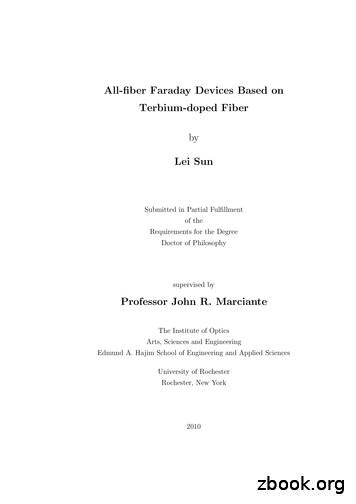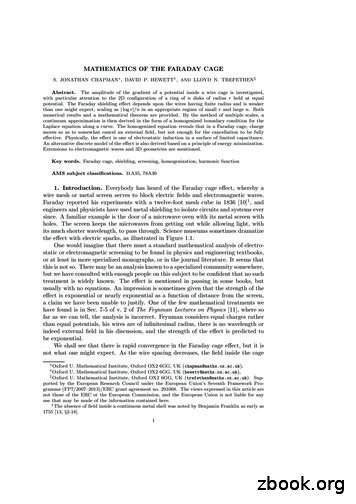Faraday’s Law
Topic 4 ‐ Cell Stoichiometry ‐ pgs 652‐656‐ In the production of elements, the refining of metals, and electroplating, the quantityof electricity that passes through a cell determines the masses of substances that reactor are produced at the electrodes‐ We know from oxidation and reduction half‐reactions, a specific number of electronsare lost or gained‐ This reduction half reaction tells us that 2 moles of electrons must be gained toproduce 1 mole of zinc.‐ This gives us our mole ratio that we can use in stoichiometry‐ In order for us to be able to use electrons as part of our stoihiometric calculations, wehave to be able to determine the number of moles or electrons that are used in ourvoltaic and electrolytic cells‐ We need to see how the charge is determined before we can calculate moles ofelectrons‐ Charge, Q, in coulombs, is determined from the electric current, I, in amperes(coulombs per second), and the time, t, in seconds, according to the followingdefinition:Ex: Modern electrolytic cells may use up to 300 kA of current. What is the charge thatpasses through one of these cells in a 24 h period?1
Faraday’s Law‐ Micheal Faraday found that 9.65 x 104 C of charge is transferred for everymole of electrons that flows in the cell.‐ In modern terms, this value is the molar charge of electrons, also called theFaraday constant, F.‐ We can use this number to convert electric charge to an amount in moles ofelectrons‐ This is similar to the way that molar mass is used to convert mass to achemical amountEx. What amount of electrons is transferred in a cell that operates for 1.25 h at a current of 0.150 A?2
Half‐Cell Calculations‐ the mass of an element produced at an electrode depends on the amount oftransferred electrons‐ a half‐reaction equation showing the number of electrons involved is necessary to dostoichiometric calculations‐ Separate calculations are carried out for each electrode, although the same chargeand, therefore, the same amount of electrons passes through each electrode in a cellEx. What is the mass of copper deposited at the cathode of a copper electrorefiningcell operated at 4.0 A for 20.0 min?Ex. Silver is deposited on objects in a silver electroplating cell. If 0.175 g of silver is to bedeposited from a silver cyanide solution in a time of 10.0 min, predict the currentrequired.Ex. A 25.72 g piece of copper metal is the anode in a cell in which a current of 0.876 Aflows for 75.0 min. Determine the final mass of the copper electrode3
Practice Sheet 111. Calculate the charge transferred by a current of 1.5 A flowing for 30 s.2. In an electrolytic cell, 87.6 C of charge is transferred in 22.5 s. Determine the electric current.3. Calculate the charge transferred by a current of 250 mA in a time of 28.5 s.4. How long, in minutes, does it take a current of 1.60 A to transfer a charge of 375 C?5. An electroplating cell operates for 35 min with a current of 1.9 A. Calculate the amount, in moles, of electrons transferred.6. A cell transferred 0.146 mol of electrons with a constant current of 1.24 A. How long, in hours, did this take?7. Calculate the current required to transfer 0.015 mol of electrons in 20 min.8. A family wishes to plate an antique teapot with 10.00 g of silver. If the current to be used is 1.80 A, what length of time, in minutes, isrequired?9. A typical Hall–Héroult cell produces 425 kg of molten aluminium in 24.0 h. Calculate the current used.4
10. Magnesium metal is produced in an electrolytic cell containing molten magnesium chloride. A current of 2.0 x 105 A is passed through thecell for 18.0 h.(a) Determine the mass of magnesium produced.(b) What mass of chlorine is produced at the same time?11. Cobalt metal is plated from 250.0 mL of cobalt(II) sulphate solution. What is the minimum concentration of cobalt(II) sulfate required forthis cell to operate for 2.05 h with a current of 1.14 A?12. A student reconstructs Volta’s electric battery using sheets of copper and zinc, and a current of 0.500 A is produced for 10.0 min. Calculatethe mass of zinc oxidized to aqueous zinc ions.13. Electroplating is a common technological process for coating objects with a metal to enhance the appearance of the object or itsresistance to corrosion.(a) A car bumper is plated with chromium using chromium(III) ions in solution. If a current of 54 A flows in the cell for 45 min 30 s, determinethe mass of chromium deposited on the bumper.(b) For corrosion resistance, a steel bolt is plated with nickel from a solution of nickel(II) sulfate. If 0.250 g of nickel produces a plating of therequired thickness and a current of 0.540 A is used, predict how long in minutes the process will take.5
A current of 2.0 x 105 A is passed through the cell for 18.0 h. (a) Determine the mass of magnesium produced. (b) What mass of chlorine is produced at the same time? 11. Cobalt metal is plated from 250.0 mL of cobalt(II) sulphate solution. What is the min
nm, which is six times larger than silica fiber. The result agrees well with Faraday rotation theory in optical fiber. A compact all-fiber Faraday isolator and a Faraday mirror are demonstrated. At the core of each of these components is an all-fiber Faraday rotator made of a 4-cm-long, 65-wt%-terbium-doped silicate fiber.
A Faraday cage can help reduce the effect of electromagnetic radiation. Due to the nature of electromagnetic radiation, two different effects occur simultaneously at the conductive enclosure of the Faraday cage. Figure 3 and Figure 4 show the general principle of a Faraday cage when an electric and magnetic field interacts with a Faraday cage.
produce standing waves on its surface. These are called Faraday waves, first described by Michael Faraday in 1831. Faraday waves are still an active area of research today, more than 150 years after their initial discovery. In current research the terms "Faraday instability" and "standing gravity waves" are also used for this phenomenon.
Faraday cage, shielding, screening, homogenization, harmonic function AMS subject classifications. 31A35, 78A30 1. Introduction. Everybody has heard of the Faraday cage effect, whereby a wire mesh or metal screen serves to block electric fields and electromagnetic waves. Faraday reported his experiments with a twelve-foot mesh cube in 1836 .
Faraday cage, shielding, screening, homogenization, harmonic function AMS subject classifications. 31A35, 78A30 1. Introduction. Everybody has heard of the Faraday cage effect, whereby a wire mesh or metal screen serves to block electric fields and electromagnetic waves. Faraday reported his experiments with a twelve-foot mesh cube in 1836 .
Faraday Cage O. A. Barro O. Lafond H. Himdi Abstract This letter presents a new recon gurable plasma antenna associated with a Faraday cage. The Faraday cage is realized using a uorescent lamp. A patch antenna with a broadside radiation pattern or a monopole antenna with an end- re radiation pat-tern, operating at 2.45 GHz, is placed inside .
properly called a Faraday Cage, named after Michael Faraday, an early pioneer in electromagnetic research. The purpose of a Faraday cage is to intercept and divert electromagnetic energy away from the box's interior, thus protecting the contents. The principles involved are fairly simple, but the proper execution is critical. In order
Re: Michael Faraday « Reply #1 - on: 17.05.2012 at 10:59 [UT 1] » Thanks for this, Jim. I am curious about Faraday's life and times. A most interesting individual.""Michael Faraday, the son of a blacksmith, was born in London in 1791.He was apprenticed to a bookbinder























